The Census Bureau counts the number of people living in the United States every decade, and the results are used to apportion the members of the U.S. House of Representatives. Maptitude for Redistricting makes it possible for state legislatures, reapportionment commissions, political parties, and interest groups to design redistricting plans that meet all kinds of objectives and comply with Federal requirements.
The Census Bureau counts the number of people living in the United States every decade, and the results support political boundary revisions. The primary reason for the establishment of the Census is set forth in the U.S. Constitution. The Constitution requires a population count to serve as the basis for the apportionment among the states of the members of the U.S. House of Representatives, with the provision that each state must have at least one representative.
Congressional districts are reapportioned among the states using a formula based on each state’s population and the total population of the country, and is simply a mathematical calculation. Each state then redistricts to divide the state up into equal population districts. The widespread use of redistricting software has made the drawing of redistricting plans easier from a technical perspective, but changes to the data and the political and legal landscapes conspire to make the redistricting process at times contentious. Maptitude for Redistricting is a version of Maptitude designed to meet the needs of those involved, and is used by almost all state legislatures, political parties of every stripe, and public interest groups.
Designed with the help of redistricting professionals and other stakeholders, Maptitude for Redistricting has a comprehensive set of the features that redistricters need. Redistricting plans are designed with all kinds of objectives and each state has its own standards for creating Congressional and legislative districts. In addition to equalizing the population of districts and complying with Federal requirements, criteria may include attempting to create compact districts, trying to keep political units and communities within a single district, and avoiding the drawing of boundaries for purposes of partisan advantage or incumbent protection. In the states where the legislature or other partisan body is in charge of redistricting, the possibility of gerrymandering (the deliberate manipulation of political boundaries for electoral advantage, usually of incumbents or a specific political party) can make the process politically contentious, especially when the majorities of the two houses of the legislature, or the legislature and the governor, are from different parties.
While there have been attempts to completely automate the creation of districts using non-partisan computer algorithms, a 2010 paper in the Duke Journal of Constitutional Law & Public Policy, Micah Altman and Michael McDonald argue that with only a small handful of variables the redistricting problem becomes incredibly complex very quickly, so complex that it is "probably impossible to create a computer program that [automatically] solves these problems optimally and reliably except in very small or limited cases."
Human intervention in the process is currently the best way to redistrict, and Maptitude supports the production of defensible, reproducible, and consistent plans, based on a robust software implementation that adheres to the standards and data required by the plan creation process. Maptitude cannot prevent intentional biases that may be introduced into plans, but does enable serious non-partisan opposition to be mounted to proposed districts, while enabling redistricting bodies to robustly defend new delineations.

Maptitude for Redistricting clients include the Democratic and Republican National Committees, the Department of Justice, state legislatures, state reapportionment commissions, county governments, city governments, educational institutions, and interest groups. Click here for a more detailed list of redistricting customers.
Maptitude for Redistricting is the professional tool for political redistricting. Designed with input from redistricting professionals, state legislatures, and political parties, Maptitude for Redistricting has the features redistricters want and is easy to learn and use.
Maptitude for Redistricting includes the latest Census geography and data, one-button conversion of existing plans to the latest TIGER geography, 35 reports (including population summary, incumbents, plan components, communities of interest, measures of compactness, and more), a state-of-the-art interface, open access to industry-standard file formats, interoperability with Google Maps and Google Earth, video tutorials, context-sensitive Help, web solutions, and more.